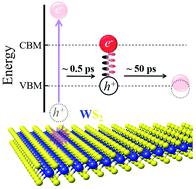当前位置:
X-MOL 学术
›
Phys. Chem. Chem. Phys.
›
论文详情
Our official English website, www.x-mol.net, welcomes your
feedback! (Note: you will need to create a separate account there.)
Ultrafast dynamics of exciton formation and decay in two-dimensional tungsten disulfide (2D-WS2) monolayers.
Physical Chemistry Chemical Physics ( IF 2.9 ) Pub Date : 2020-07-20 , DOI: 10.1039/d0cp03220d Zeynep Ezgi Eroglu 1 , Olivia Comegys 1 , Leo S Quintanar 1 , Nurul Azam 2 , Salah Elafandi 2 , Masoud Mahjouri-Samani 2 , Abdelaziz Boulesbaa 1
Physical Chemistry Chemical Physics ( IF 2.9 ) Pub Date : 2020-07-20 , DOI: 10.1039/d0cp03220d Zeynep Ezgi Eroglu 1 , Olivia Comegys 1 , Leo S Quintanar 1 , Nurul Azam 2 , Salah Elafandi 2 , Masoud Mahjouri-Samani 2 , Abdelaziz Boulesbaa 1
Affiliation

|
Excitons in two-dimensional transition metal dichalcogenide monolayers (2D-TMDs) are of essential importance due to their key involvement in 2D-TMD-based applications. For instance, exciton dissociation and exciton radiative recombination are indispensible processes in photovoltaic and light-emitting devices, respectively. These two processes depend drastically on the photogeneration efficiency and lifetime of excitons. Here, we incorporate femtosecond pump–probe spectroscopy to investigate the ultrafast dynamics of exciton formation and decay in a single crystal of monolayer 2D tungsten disulfide (WS2). Investigation of the formation dynamics of the lowest exciton (XA) indicated that the formation time linearly increases from ∼150 fs upon resonant excitation, to ∼500 fs following excitation that is ∼1.1 eV above the band-gap. This dependence is attributed to the time it takes highly excited electrons in the conduction band (CB) to relax to the CB minimum (CBM) and contribute to the formation of XA. This is confirmed by infrared measurements of electron intraband relaxation dynamics. Furthermore, pump–probe experiments suggested that the XA ground state depletion recovery dynamics depend on the excitation energy as well. The average recovery time increased from ∼10 ps in the case of resonant excitation to ∼50 ps following excitation well above the band-gap. Having the ability to control whether generating short-lived or long-lived electron–hole pairs in 2D-TMD monolayers opens a new horizon for the application of these materials. For instance, long-lived electron–hole pairs are appropriate for photovoltaic devices, but short-lived excitons are more beneficial for lasers with ultrashort pulses.
中文翻译:

二维二硫化钨(2D-WS2)单层中激子形成和衰减的超快动力学。
二维过渡金属二硫化碳单分子膜(2D-TMD)中的激子至关重要,因为它们主要参与基于2D-TMD的应用。例如,激子离解和激子辐射复合分别是光伏和发光器件中必不可少的过程。这两个过程极大地取决于光生效率和激子寿命。在这里,我们结合飞秒泵浦-探针光谱技术来研究单层2D二硫化钨(WS 2)单晶中激子形成和衰变的超快动力学。最低激子(X A)表明形成时间从共振激发时的〜150 fs线性增加到激发后的〜500 fs,即比带隙高约1.1 eV。这种依赖性归因于导带(CB)中高度激发的电子弛豫到CB最小值(CBM)并有助于X A形成的时间。这通过电子带内弛豫动力学的红外测量得到证实。此外,泵浦探针实验表明X A基态损耗恢复动力学也取决于激发能。平均恢复时间从共振激励情况下的约10 ps增加到远高于带隙的激励后的约50 ps。具有控制在2D-TMD单层中生成短寿命或长寿命电子-空穴对的能力,为这些材料的应用开辟了新的视野。例如,长寿命的电子-空穴对适用于光伏设备,而短寿命的激子对具有超短脉冲的激光器更有利。
更新日期:2020-08-05
中文翻译:

二维二硫化钨(2D-WS2)单层中激子形成和衰减的超快动力学。
二维过渡金属二硫化碳单分子膜(2D-TMD)中的激子至关重要,因为它们主要参与基于2D-TMD的应用。例如,激子离解和激子辐射复合分别是光伏和发光器件中必不可少的过程。这两个过程极大地取决于光生效率和激子寿命。在这里,我们结合飞秒泵浦-探针光谱技术来研究单层2D二硫化钨(WS 2)单晶中激子形成和衰变的超快动力学。最低激子(X A)表明形成时间从共振激发时的〜150 fs线性增加到激发后的〜500 fs,即比带隙高约1.1 eV。这种依赖性归因于导带(CB)中高度激发的电子弛豫到CB最小值(CBM)并有助于X A形成的时间。这通过电子带内弛豫动力学的红外测量得到证实。此外,泵浦探针实验表明X A基态损耗恢复动力学也取决于激发能。平均恢复时间从共振激励情况下的约10 ps增加到远高于带隙的激励后的约50 ps。具有控制在2D-TMD单层中生成短寿命或长寿命电子-空穴对的能力,为这些材料的应用开辟了新的视野。例如,长寿命的电子-空穴对适用于光伏设备,而短寿命的激子对具有超短脉冲的激光器更有利。











































 京公网安备 11010802027423号
京公网安备 11010802027423号